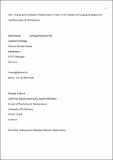Files in this item
Change point analysis of travel routes reveals novel insights into foraging strategies and cognitive maps of wild baboons
Item metadata
| dc.contributor.author | Noser, Rahel | |
| dc.contributor.author | Byrne, Richard William | |
| dc.date.accessioned | 2015-07-07T11:40:02Z | |
| dc.date.available | 2015-07-07T11:40:02Z | |
| dc.date.issued | 2014-04-16 | |
| dc.identifier | 55557692 | |
| dc.identifier | 816aead5-bb25-4fe3-b852-c8078b17a6ee | |
| dc.identifier | 84898927421 | |
| dc.identifier | 000334328100002 | |
| dc.identifier.citation | Noser , R & Byrne , R W 2014 , ' Change point analysis of travel routes reveals novel insights into foraging strategies and cognitive maps of wild baboons ' , American Journal of Primatology , vol. 76 , no. 5 , pp. 399–409 . https://doi.org/10.1002/ajp.22181 | en |
| dc.identifier.issn | 0275-2565 | |
| dc.identifier.other | ORCID: /0000-0001-9862-9373/work/60630559 | |
| dc.identifier.uri | https://hdl.handle.net/10023/6918 | |
| dc.description.abstract | Efficient space use is a critical challenge for animals relying on stationary resources. It is often difficult with purely observational methods to gain unambiguous insight into any ability of primates to manage and process spatial information. Investigating the visible signs of the decision processes underlying space use often leaves open important issues. We applied the change point test [Byrne et al. (2009). Anim Behav 77: 619–631], a statistical tool to objectively determine change points (CPs) in animal travel paths, to investigate to what degree directional changes in our study group's (Papio ursinus) dry season ranging were associated with important resources and prominent landmarks. One‐third of directional changes were associated with fruit feeding, 1/3 with traveling, and 1/3 with dry matter feeding, travel feeding and with drinking. When directional changes were associated with traveling, the subsequent directional changes were likely to result in fruit feeding. Fruit feeding mostly occurred at the apex of the day journeys, while drinking, dry matter feeding, and travel feeding often occurred along straight travel segments. The majority of directional changes did not occur in clusters at distinctive locations, but at distances of more than 120 m apart from each other, many of them along prominent landmarks. We conclude that the CPs do not represent nodes or route bends of a network map. Rather, they represent (1) locations where the decision to turn back to their sleeping site was taken, and (2) locations next to important landmarks (changes of slope, car tracks) where slight adjustment of a movement direction was possible. We found no evidence for a Euclidean map and discuss our findings in the light of a network map representation of space. | |
| dc.format.extent | 732223 | |
| dc.language.iso | eng | |
| dc.relation.ispartof | American Journal of Primatology | en |
| dc.subject | Spatial cognition | en |
| dc.subject | Change point analysis | en |
| dc.subject | Baboon travel routes | en |
| dc.subject | Network map | en |
| dc.subject | Large-scale space | en |
| dc.subject | QL Zoology | en |
| dc.subject | BDY | en |
| dc.subject.lcc | QL | en |
| dc.title | Change point analysis of travel routes reveals novel insights into foraging strategies and cognitive maps of wild baboons | en |
| dc.type | Journal article | en |
| dc.contributor.institution | University of St Andrews. School of Psychology and Neuroscience | en |
| dc.contributor.institution | University of St Andrews. Centre for Social Learning & Cognitive Evolution | en |
| dc.identifier.doi | 10.1002/ajp.22181 | |
| dc.description.status | Peer reviewed | en |
This item appears in the following Collection(s)
Items in the St Andrews Research Repository are protected by copyright, with all rights reserved, unless otherwise indicated.

